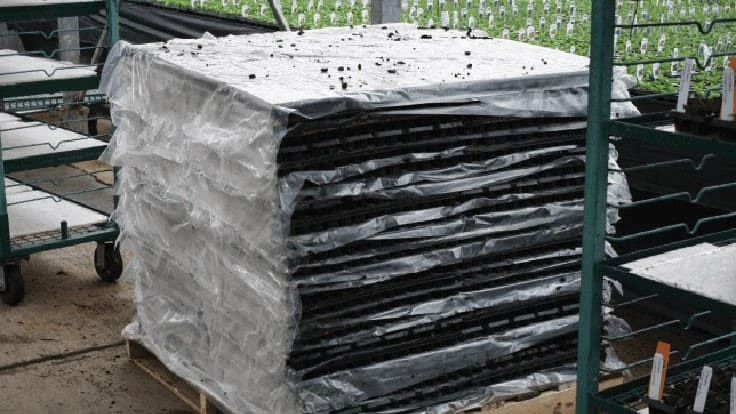

Hold on to your hats, because spring is here!
With all the flurry of activity, every step that can be taken to ensure smooth and timely operations is useful. One of the most important things to prepare for production is growing substrate and containers for planting. This Production Pointers column will focus on preparing substrate and containers for timely and successful planting during the spring.
The moisture content of substrate is an important consideration to make sure seed germination, adventitious root formation on cuttings, and root growth from transplanted young plants is successful. If there is insufficient moisture in the substrate, a few problems can occur.
First, if germination substrate for plug trays is too dry, seed can become buried too deep if placed on dry substrate or covered up from dry substrate “bouncing” around when it passes through a watering line or during its first irrigation.
Following transplanting, dry substrate can result in containers being filled with an excessive amount of substrate. Since several substrate components expand upon rewetting, filling containers with insufficiently moistened substrate can result in too much substrate filling each container and, when irrigated, the substrate will expand. As a result of the excessive substrate volume expanding, less pore space will exist in the container and too much moisture may be held in the root zone. A dry substrate may have trouble rewetting if it contains components that are hydrophobic when dry, like sphagnum peat moss.
The use of wetting agents in substrate will help improve the rewetting of those substrate components like sphagnum peat moss that become hydrophobic when dry. If a substrate is too wet when containers are filled, excessive shrinkage could occur when the substrate starts to dry down, resulting in less growing substrate in each container and an excessive headspace.
When moistening media prior to filling containers, a good rule of thumb is that the substrate is properly moistened when you can take a handful of substrate and squeeze it into the form of a ball without water being expelled, yet it will still hold its shape when you open your hand.
Prefilling containers — whether plug trays, flats with packs, 4.5-inch containers in shuttle trays, or hanging baskets in large patio containers — can help keep planting lines running smoothly and avoid costly delays when trying to complete planting in a timely manner.

As previously mentioned, make sure the substrate is properly moistened prior to filling. After containers are filled, one way to help maintain moisture in the substrate is to wrap the stacks of pre-filled containers with plastic wrap or saran (not to be confused with the black saran shade cloth material).
Alternatively, place plastic on top of the substrate between layers of trays or containers. This will help reduce moisture loss from the substrate and minimize shrinkage prior to potting.
Another thing to be very mindful of when prefilling containers and stacking them is to avoid “nesting,” where trays or containers placed on top of one another fit together and end up compressing the substrate in the container below. When substrate gets compressed prior to planting, it can result in a few different problems in production.
First, compressed substrate will have less air space than un-compressed substrate. Root growth will not be as vigorous with less pore space, and growth and water use will be slower. Another challenge is that when the same crop is planted in compressed and un-compressed substrate and are grown in the same block in the greenhouse, it will result in an uneven pattern in water use and irrigation requirements. The lack of uniformity during production can lead to a lack of uniformity in finished crop quality.
To avoid compression, offset or rotate trays somewhere around 10° to 20° (or as needed) as they are placed on top of each other in an alternating arrangement. This will help avoid any compression and maintain the physical integrity of the substrate prior to planting.
Are you using controlled-release fertilizers (CRFs) to provide mineral nutrients to your plants? When using CRFs, they are either: 1) incorporated into the growing substrate prior to planting; or 2) top-dressed onto the substrate surface after planting. When possible, it is usually more efficient to avoid top-dressing since it can be a labor-intensive task. Incorporating CRF into substrate before planting is a more labor-efficient method of providing CRF to plants.
There are also other benefits to incorporating CRF into growing substrate. For one, fertilizer prills are distributed evenly throughout the growing substrate and root zone, allowing nutrients to diffuse closer to plant roots.
Another benefit is that, by incorporating prills into the substrate, fertilizer is not lost if and/or when the container headspace fills up with water and flows over the side of the container, or if a container tips over onto its side.
When mixing CRF into substrate, be careful about how early the substrate and CRF are mixed, as well as what temperature it is kept at after mixing. If CRF is mixed into substrate a long time prior to planting and/or stored to warm, excessive nutrients are released from prills into the growing substrate. Once seedling plugs or rooted cutting liners are transplanted into the substrate, the excessive nutrients released prior to planting can cause damage to the roots from excessive soluble salts and a high electrical conductivity.

Explore the February 2022 Issue
Check out more from this issue and find your next story to read.
Latest from Greenhouse Management
- Anthura acquires Bromelia assets from Corn. Bak in Netherlands
- Top 10 stories for National Poinsettia Day
- Langendoen Mechanical hosts open house to showcase new greenhouse build
- Conor Foy joins EHR's national sales team
- Pantone announces its 2026 Color of the Year
- Syngenta granted federal registration for Trefinti nematicide/fungicide in ornamental market
- A legacy of influence
- HILA 2025 video highlights: John Gaydos of Proven Winners





